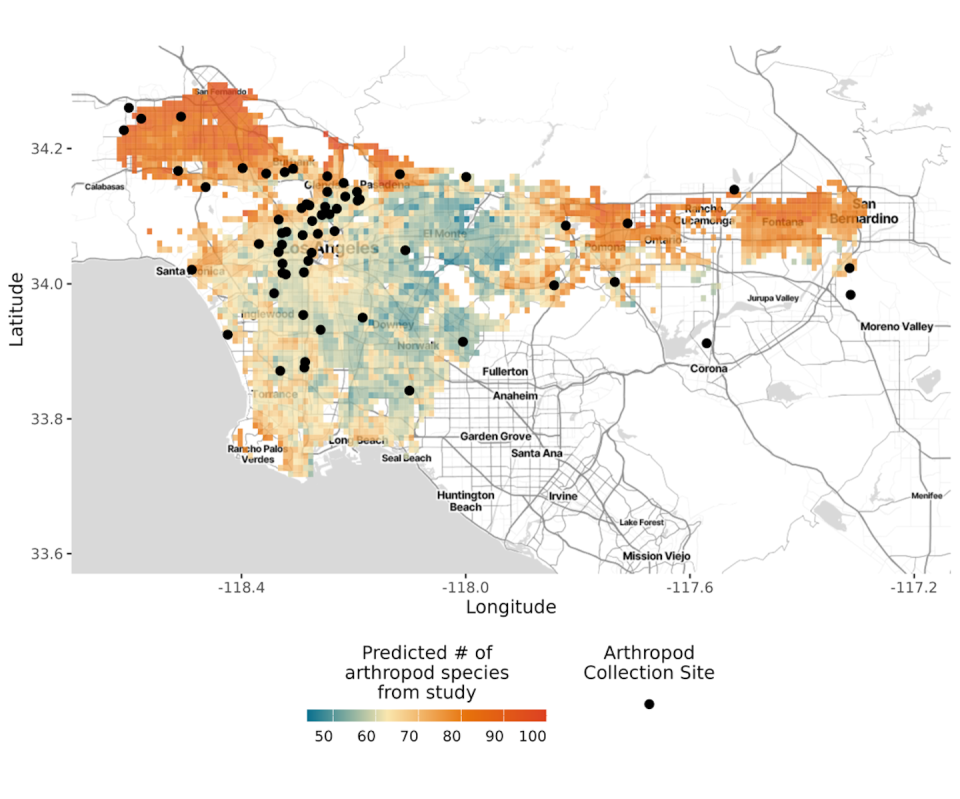Proximity to mountains and year-round temperature stability are the most important determinants of insect biodiversity in Los Angeles, according to a study we co-authored with Brian V. Brown of the Los Angeles Museum of Natural History and colleagues at the University of Southern California and California State University.
The project used data from the BioSCAN project, in which volunteers from across Los Angeles allowed insect traps to be set up on museum property between 2014 and 2018.

The analysis showed some surprising results. For example, land values had little effect on the overall diversity of arthropods, particularly spiders and insects. This finding calls into question the “luxury hypothesis,” the idea that wealthier neighborhoods, which tend to have more trees, always have greater biodiversity — an assumption that often holds true for mammals, including birds and bats.
The BioSCAN study identified more than 400 different species of insects in Greater Los Angeles, many of which have managed to survive despite pavement and habitat loss.
In fact, urban environments can be attractive to some invasive arthropod species. Often called urban opportunists, these species often arrive in waves that displace or restrict existing species. For example, about 20 years ago, Los Angeles’ native black widow spiders (Latrodectus hesperus) began to be replaced by brown widow spiders (Latrodectus geometricusRecent evidence suggests that these intruders have now been replaced by the noble false widow spiders (Steatoda nobilis).
Why is it important?
Insect populations are essential to humans, who rely on them to pollinate, decompose plant and animal material, and control pests. These services are important in urban as well as rural environments and are provided free of charge by insects.
Imagine a city where organic waste, such as dead animals or plant matter, does not decompose. A city without insects would also mean an environment without birds and other wildlife, most of which depend on insects for food. Such a place would also have no flowers, fruits, or vegetables growing. In fact, a world without insects would be a world without humans.
Low arthropod diversity can lead to ecosystem imbalance. A 2022 study found that pests like sap-sucking aphids can grow out of control in highly urban areas because there aren’t enough predators, like insects and spiders, to keep them in check.
Most biodiversity studies are conducted in natural or protected areas, but scientists increasingly recognize that urban areas can be home to many species. Understanding biodiversity in urban areas is important because cities are expected to continue to spread – the United Nations predicts that urban populations will increase by 2.5 billion by 2050.
Still unknowns
While we now know which factors most influence arthropod diversity in Los Angeles, we do not fully understand how this diversity translates into healthy urban ecosystems.
Scientists know that more species lead to healthier urban ecosystems, but not all species contribute equally. For example, planting pollinator-friendly plants is a relatively easy intervention in urban environments, but it won’t benefit all insect species.
What’s next?
As part of the BioSCAN project, volunteers also allowed bioacoustic monitors to be placed on their properties so that future studies could include bats, which are also important for pollination and pest control in cities.
Additionally, researchers at the University of Southern California are continuing to examine the same data set to understand seasonality in urban arthropod communities. In a warming climate, this information could help predict future insect population changes.
Overall, information gained from these studies can help inform urban planning and development to support insect biodiversity, particularly as cities expand through urban sprawl.
This article is republished from The Conversation, a nonprofit, independent news organization that brings you facts and trusted analysis to help you understand our complex world. By Laura Melissa Guzman USC Dornsife College of Letters, Arts and Sciences; Charles Lehnen, USC Dornsife College of Letters, Arts and Sciencesand Teagan Baiotto, University of Southern California
Read more:
Laura Melissa Guzman receives funding from the Foundation for Conservation, Food and Health.
Charles Lehnen receives funding from external sources, such as the Iguanas in Balance Grant and the Gold Family Fellowship, and from internal USC funding sources, such as the USC Provost Fellowship, the USC Graduate School Travel/Research Award, the Doctoral Academy Fellowship and Research Fund, and the USC Graduate Student Council GSG Professional Development Fund.
Teagan Baiotto does not work for, consult, own shares in, or receive funding from any company or organization that would benefit from this article, and has disclosed no affiliations beyond her academic appointment.